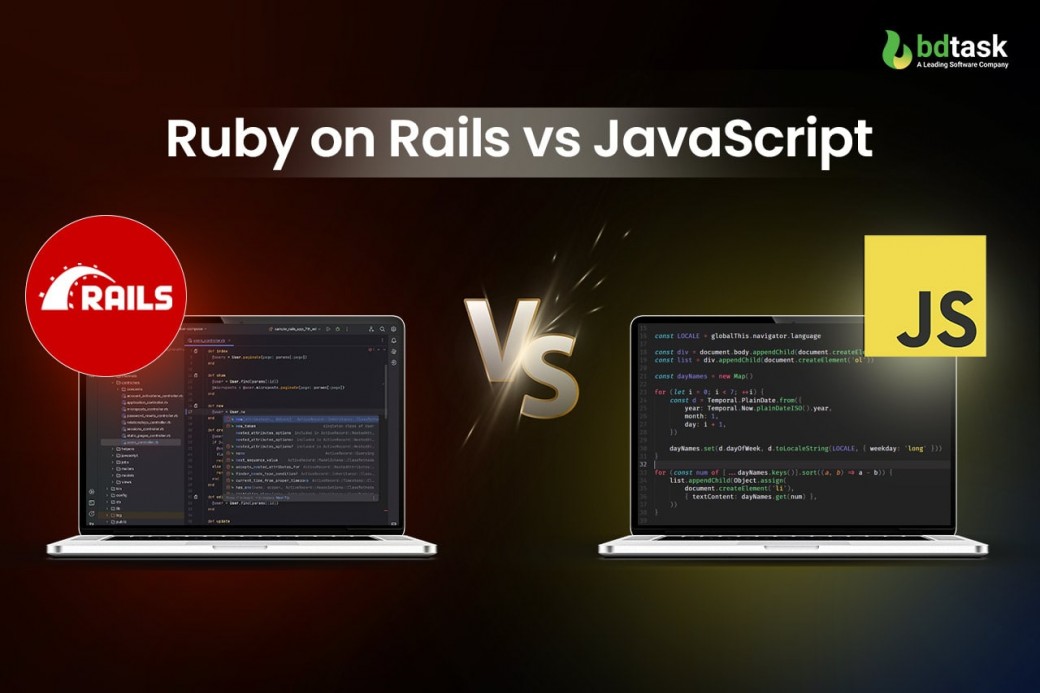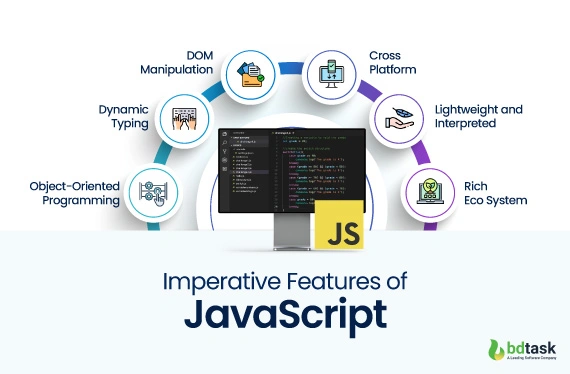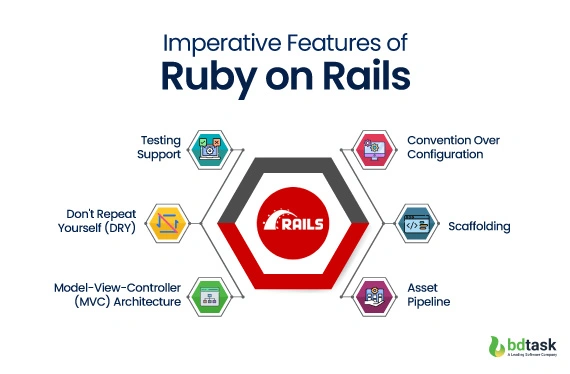Ruby on Rails vs JavaScript - Key Differences Explained

Ruby on Rails and JavaScript are very popular in web technology and the IT industry. Both are combined with the advanced features and benefits. It has become a challenge to choose the suitable framework for web applications.
In web development, it is very important to select the right framework for the project. So, you must choose the best technologies according to your projects and requirements.
However, in this situation, a good comparison between Ruby on Rails vs JavaScript can help. It helps to know the pros and cons and limitations of this framework. Here, we will explore Ruby on Rails vs JavaScript, which will help you to choose the best one.
What is Ruby on Rails
Ruby on Rails is a web application framework based on Ruby. It is mainly used for web development. Ruby on Rails is also known as a server-side web application or back-end framework.
Ruby on Rails was built by David Heinemeier Hanson in 2003. And, in 2004, it was released as an open-source web application framework. Due to its high speed and imperative features, it has become very popular.
Moreover, the Model View Controller (MVC) architecture pattern, Convention over Configuration, and Don't Repeat Yourself (DRY) have increased its efficiency.
It provides a synchronized programming environment that promotes web development, and has an impact on the software development process. So, definitely Ruby on Rails is a strong and efficient back-end framework that has brought revolutionary changes to web development.
Imperative Features of Ruby on Rails

Within a short time, Ruby on Rails became widely famous and gained popularity among developers. It offers a complete package of unique and advanced features. Those features allow its user to develop hassle-free web applications. Moreover, Ruby on Rails increases user experience by providing higher speed and efficient working capability.
Here, we will mention the imperative features of Ruby on Rails.
-
Model-View-Controller (MVC) Architecture
Model View Controller (MVC) Architecture is one of the most key features of Ruby on Rails. It helps to separate the applications into different parts. And making it easier to organize, understand, and maintain.
The MVC architecture pattern provides divisions into three distinct parts, and they are model, view, and controller. The model combines the data and logic. On the other hand, the view maintains the user interface and the controller controls information between the view and the model.
-
Don't Repeat Yourself (DRY)
One of the major problems of web development is writing the same code again and again. In that case, the DRY features help to avoid these concerns.
The DRY method helps to minimize code redundancy and maintainability. It plays a major role in web development and provides effective web applications.
-
Testing Support
In web development, testing is important. It ensures the codes are free from error and high quality. When any developer finds an error early, it helps to make the development process easier. Ruby on Rails has incredible testing support features that increase its efficiency.
-
Convention over Configuration (CoC)
Convention over configuration cut down the decision-making process. It provides a clear and detailed view of how to organize the applications.
Moreover, it helps the developer to erase the unwanted or unnecessary characteristics. This process speeds up the web application construction process.
-
Scaffolding
Automatic code generation is critical for web development. It reduces time and code complexity. Ruby on Rails has scaffolding features that provide an automatic code-generating system.
It helps to generate code for the model, controller, and view sections. However, it helps with early code generation and completing the project without any issues.
-
Asset Pipeline
Ruby on Rails has the features of an asset pipeline. It helps to manage the project's assets, such as CSS, images, etc. However, this feature increases the user experience and improves the application's overall performance by reducing the loading times.
What are the Advantages of Ruby on Rails
Ruby on Rails has multiple advantages. It helps developers to build efficient and secure web applications. Here we will list the most beneficial advantages of Ruby on Rails. Stay with us, and it will help you to choose between Ruby on Rails vs JavaScript.
-
Accelerated Growth
The major benefit of the Ruby on Rails framework is accelerated growth. It helps to reduce the configuration by prioritizing the convention.
The convention over configuration methods cut down the cost and time of web applications. So, the overall web application build process grows rapidly, and the developer can start new projects easily.
-
Cost-Effectiveness
Ruby on Rails is cost-effective compared to other frameworks. It has faster development cycles, which reduce the overall development time and cause low-cost web applications.
So, if you are bound to build a web application with lower cost, then the Ruby on Rails framework is perfect for you.
-
Collective Endorsement
One of the major benefits of Ruby on Rails is collective endorsement or strong community support. It means that the developer can get plenty of resources that help in the developing process.
However, this community support allows the developer to solve any issues easily and make the best output. It also helps to cope with the trends.
-
Built-in Security
Built-in security is a core feature of Ruby on Rails. It secures the web application from cross-site scripting or SQL. Moreover, it also helps to build a secure and reliable web application by maintaining high security.
-
Maintainability
Ruby on Rails provides high maintainability. It provides clean codes that promote code reuse. These features help to maintain and further update.
-
Open-source Libraries
Ruby on Rails has plenty of open-source libraries. These libraries are known as gems. However, these libraries can improve the different functions that exist in web applications. The developer can get access to these libraries from the main documentation.
-
Front-end Compatibility
As we know, Ruby on Rails is a back-end framework, but it also has front-end compatibility. It means you can work with Ruby with other frameworks. These frameworks include Vue, Node.js, React.js, Angular.js, etc. It ensures seamless web application development.
Limitations of Ruby on Rails
Every framework has some boundaries or limitations. Ruby on Rails is not out of the list. But the limitations of Ruby on Rails are far fewer compared to other frameworks.
Here, we will discuss the cons or limitations of Ruby on Rails. This will make it easier to understand Ruby on Rails vs JavaScript.
-
Lower Flexibility
Ruby on Rails has the convention over configuration features. This feature helps to boost web development speed, but it has some limitations. It causes lower flexibility for customizable applications.
So, if you are planning for an application that needs customization and specialization, then Ruby on Rails is not suitable. However, this framework is hard-dependent, which means the developer faces problems when they need some custom functionalities.
-
Performance Issues
Ruby on Rails has some performance issues. It includes slower run time speed, boot time, scaling challenges, etc. So, if you want a high-speed application, then you should go with another framework like Java. Moreover, Ruby on Rails has less speed boot time.
-
Continuous Evaluation
One of the major disadvantages of Ruby on Rails is continuous evaluation. This framework is continuously being updated and releasing new versions. In that case, the web developer faces problems coping with changes. These are the major limitations of the Ruby on Rails framework.
What is JavaScript
JavaScript is a very popular object-oriented programming language. It is widely used in web development. JavaScript is highly flexible and equally used for backend and frontend development.
However, it is mainly used for web browsing and web based applications. In 1995, Brendan Eich created JavaScript. It comes with plenty of qualities and features, which increased its popularity.
JavaScript is popular for curly bracket syntax, dynamic typing, etc. Moreover, content modification and instantaneous manipulation are some of its greatest characteristics.
It helps to increase user experience. JavaScript is also known as a scripting language and allows developers to build efficient web applications. It has features like auto-complete text suggestions, animated graphics, interactive forms, etc.
JavaScript can be integrated with other languages and has the ability to perform complex functionality.
Imperative Features of JavaScript

JavaScript is a combination of advanced features. It is a versatile programming language that supports both server-side development and client-side development. However, it provides different fundamental ideas, which help the developers to design productive codes.
In this article we will cover the core principles of JavaScript. Try to read and understand the core features; it will help to differentiate Ruby on Rails vs JavaScript.
-
Object-Oriented Programming(OOP)
Object-oriented programming (OOP) is one of the major features of JavaScript. In JavaScript, object orientation provides an allowance to structure and organize the codes. In this system, the code is organized using objects.
Moreover, it helps to maintain a strong relationship in codes. Object orientation supports multiple key functions such as polymorphism, encapsulation, inheritance, etc.
An object-oriented and functional programming feature allows you to build a flexible web application and structure codes.
-
Dynamic Typing
JavaScript has dynamic typing features. It means the developers do not have to declare the variable types during creation. The data types should be declared and checked at runtime.
Dynamic typing has some important characteristics, such as no explicit type declaration, implicit type conversion, runtime type checking, etc. However, this characteristic helps in rapid development and provides flexibility and conciseness.
-
DOM Manipulation
DOM stands for Document Object Model. In JavaScript, DOM manipulation gives allowances to modify or update the content and structure of HTML elements of web pages.
There are some core aspects of DOM manipulation, and these are assessing elements, modifying styles, modifying elements' content, event handling, etc. It is very crucial for applications. It helps to update or modify the content and not be required to reload the page.
-
Cross-Platform
JavaScript has cross-platform supported features. It means any code written in JavaScript can run on any platform without any issues. JavaScript is equally suitable for all the browsers. This feature has increased its user experience and working ability.
-
Lightweight and Interpreted
JavaScript is lightweight and interpreted. It can execute any code without extensive resources. However, JavaScript can be directly performed by the browser, and it does not require any individual compilation.
-
Rich Ecosystem
JavaScript has different types of libraries and frameworks. It includes React, Vue.js, Angular, etc. And these libraries are very helpful for development.
What are the Advantages of JavaScript
JavaScript has gained popularity worldwide. It is one of the most widely used programming languages. It has multiple advantages and is very essential for web development. Here, we will discover the advantages of JavaScript.
Let's explore the benefits of using JavaScript, which make it widely popular.
-
Versatility
JavaScript is a versatile language. It is one of the most popular front-end languages and is equally efficient for back-end development. JavaScript is used for web applications.
However, it is not only limited to web applications; JavaScript is also used for mobile apps development, server-side applications, games, etc. Simply, it is the most versatile language that can be used for different applications.
-
Simple and Easy to Learn
JavaScript is very simple and easy to learn. Its simplicity makes it more popular. It is considered one of its high benefits. The structure of JavaScript is very simple, and it becomes easier to understand for the developers. Moreover, it has extensive documentation that helps to refine code and debug.
-
Browser Support
JavaScript supports all the major and popular web browsers. One of the major difficulties that developers face is the need for cross-platforms for developing codes. But, with the help of JavaScript, developers can easily solve this issue. It supports multiple browsers that eliminate the demand for cross-platform web applications.
-
Speed
JavaScript is well known in the tech industry for its speed. The JavaScript client-side execution system allows most of the process in the user's browser. As a result, the server load reduced, and the application got a faster response. So, if you want fast-loading applications, JavaScript is better than others.
-
Rich Interface
JavaScript is popular among the developers for the creation of interactive user interfaces. It plays a crucial role in web applications. And it includes real-time response, dynamic content updates, UI elements, client-side validation, etc. This interface is important to improve user experience, faster performance, and increased interactivity. Due to its rich interface, top software companies use JavaScript for developing web applications.
-
Asynchronous Programming
JavaScript supports asynchronous programming. It allows web applications to respond faster and quicker. As a result, the developers can handle multiple processes at a time.
Moreover, different critical tasks in web development, such as getting resources or processing user input, depend on asynchronous programming. So, in that case, JavaScript performs better, and developers get high benefits.
-
Large Community
JavaScript is a complete package of frameworks, resources, and libraries. So, while working on JavaScript, developers get plenty of resources. It helps to build more complex applications. Moreover, due to plenty of resources, developers can easily get solutions while they face any problems.
Limitations of JavaScript
JavaScript is considered to be the most powerful programming language for web development. It has plenty of advantages. But there are some limitations of JavaScript, and you can consider them as the drawbacks of JavaScript. One of the major limitations of JavaScript is multithreading, and it cannot perform well for low-level operations.
Let's break down the details of the limitations of JavaScript.
-
Security Concerns
Security concerns are one of the major limitations of JavaScript. And these security concerns come from different ways; they include code visibility, client-side security, etc.
In JavaScript, the code is visible to the others who have access to the webpage. It makes vulnerability to malicious exploitation.
To solve this issue, the developers need to provide necessary security procedures. Which creates extra workload for the web application creation process.
-
Debugging Challenges
In JavaScript, the developers sometimes face debugging challenges. Debugging is very hard and difficult in local web development. As we know, JavaScript is compatible with any browser, resulting in some browsers not providing detailed error messages. So, it becomes very hard to find and solve these problems.
-
Performance Issues
JavaScript has some performance issues, and it is considered the limitations of JavaScript. These performance issues include rendering speed, browser inconsistency, single-thread nature, etc.
Sometimes developers face slow page rendering, and most of the time it happens with complex projects. Moreover, due to multiple browser support features, it can perform differently in different browsers.
-
Limited Multithreading
JavaScript has limitations in multithreading. It mainly operates in a single thread. As a result, the system can face difficulties performing multiple tasks. Although, asynchronous programming helps to solve these issues. But it completely does not eliminate the challenges.
Choosing Between Ruby on Rails vs JavaScript

Throughout the article, we have covered several topics. For example, what are the advantages of Ruby on Rails? What are the features of Ruby on Rails? Disadvantages of Ruby on Rails, what is JavaScript, features of JavaScript, and what are the advantages and disadvantages of JavaScript?
Now, we will go through the tabular method to differentiate between Ruby on Rails vs JavaScript.
|
Feature |
Ruby on Rails |
JavaScript |
|
Language |
Ruby |
JavaScript |
|
Type |
Ruby on Rails is a server wide web application framework |
JavaScript is a client side programming language and framework |
|
Year of Development |
2003 |
1995 |
|
Use Case |
Mainly Backend |
Full - Stack (Frontend and Backend) |
|
Database |
Support different databases such as MySQL , PostgreSQL, etc |
JavaScript interacts with databases throughout RESTful APIs |
|
Performance |
Comparatively lower |
Very fast |
|
Security |
Higher |
Comparatively lower |
|
Community and Ecosystem |
Mature and Stable |
Huge, very fast growing, active |
|
Scalability |
Scale well but sometimes need optimization |
Higher Scalability |
|
Resource |
Low |
High |
|
Documentation |
Less Extensive |
Suitable for advanced developers |
|
Popularity |
Comparatively High |
Comparatively High |
|
Job Demand |
Lower than JavaScript |
High Demand |
Frequently Asked Question (FAQ)
Here we have answered the more frequent questions that are being asked when choosing between Ruby on Rails and JavaScript.
1. Is Ruby on Rails or JavaScript better for beginners?
When you are beginners, you may be confused about which one is easier and more user-friendly. In that sense, the Ruby on Rails framework is more user-friendly than JavaScript. So, it is easier to learn Ruby on Rails easily and work with it. But JavaScript also has very good documentation, which also provides all the resources. But it can be a little bit harder to understand and apply to web development.
2. Can Ruby on Rails replace JavaScript?
No. Ruby on Rails never replaced JavaScript. Both are not the same, so there is no possibility to replace one by another. Ruby on Rails can only be used for backend applications; on the other hand, JavaScript is used for both backend and frontend.
3. Is Ruby on Rails better than javaScript?
The answer to this question is very complex. It depends on the project and your requirements. If you want to build a complex web application, then JavaScript works amazingly, but when you want high-speed applications, then Ruby is awesome. So, you can not tell Ruby on Rails is better than JavaScript. Both have specific benefits and limitations.
4. Can Ruby on Rails work with JavaScript?
Yes. Ruby on Rails can work with JavaScript. Both can be used together to develop rich, complex, and modern web applications.
5. Is Ruby on Rails full-stack?
Yes. You can consider Ruby on Rails as a full-stack framework. As it works well in backend development, the tools Ruby provides can be used for frontend also. So, you can consider Ruby on Rails a full-stack framework.
Final Thought
Which is better, JavaScript or Ruby on Rails? Choosing between Ruby on Rails and JavaScript depends on your projects and goals. Moreover, you must focus on long-term growth factors while choosing Ruby on Rails vs. JavaScript.
Both have plenty of benefits and some limitations. When you want to build a data-driven web application that works quickly and efficiently, then Ruby on Rails works well.
Moreover, JavaScript is considered to be the heart of web development. It is a full-stack programming language that works equally for backend and frontend. Now the choice is yours, and you must choose the best ones that suit your projects










